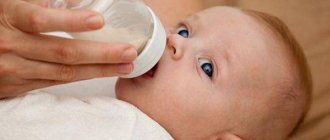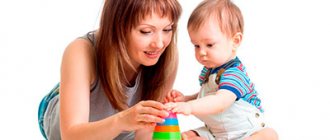10/08/2020 Reading time: 5 min 9881 0
Babies are growing rapidly. It seemed like only recently a small, squeaking bundle appeared in the house, and it’s hard for him to even focus his eyes, and now he’s already humming, looking around with interest and getting ready to celebrate his first birthday. 11–12 months is the age when the child begins to carefully try to walk with support or independently, he continues to cut his teeth, and he actively learns about the world around him. This period, which has come so quickly, causes natural anxiety in parents: what should a child be able to do in a year, is he developing normally. It’s worth saying right away that all children are individual, and you shouldn’t compare your baby with others, it’s better to focus on medical criteria.
Features of child development at 1 year
Compared to previous months, the baby becomes much more active and inquisitive. Parents begin to notice this after the first half of the year, but by the age of one year the child becomes even more intelligent and curious. Its weight is approximately three times greater than at birth, and on average is 10–12 kg, and such children are about 72–77 cm tall. Much depends on genetics, on how quickly the baby’s parents grew. The main thing is that the ratio of height and weight is organic, for example, a tall child weighs more. If the baby slightly does not fit into the criteria, there is no reason to worry, even if someone you know has a child at that age that looks a little different. Every baby is unique.
Nutrition for a 16 month old baby
At this age, four meals a day are considered complete. Menu includes:
- Breakfast - cheese, bread, milk, tea, cocoa, boiled eggs, cheesecakes. Porridge: semolina, oatmeal, rice, corn, buckwheat.
- Lunches - vegetables, side dishes of cereals, potato or vegetable puree, noodles; fish and meat main courses: casseroles, steamed cutlets or meatballs, boiled chicken or fish. Soups: rassolnik, cabbage soup, borscht, vegetable, vermicelli with meatballs. Vegetable salads: cabbage, beetroot, cucumber, carrot. Greens: spinach, lettuce, parsley.
- Afternoon snacks - milk, tea or kefir, cookies, fruit, cottage cheese casserole or cottage cheese with fruit, yogurt.
- Dinners - casseroles or pureed vegetables, porridge, a sandwich with jam and butter, milk, fruit.
Nutrition at this age is complete, but for the sake of safety, it is still advisable to give food in crushed form or chopped into small pieces. It is important to introduce large foods gradually so that the child can master the ability to chew.
Porridge for baby's breakfast
It is also worth paying attention to the fact that the child is already developing taste preferences, with periodic changes. They must be taken into account, and in no case should you force him to eat an unloved product, however, you also cannot completely indulge his whims, since in the future it will be extremely difficult to please the little gourmet.
Temporary changes may also occur in the feeding schedule, it all depends on how well the child ate before or if it was not possible to feed him at the right time. But it is important to monitor the time intervals between meals.
There are often situations when the baby eats little or refuses at all, and if everything is fine with health, there is no need to worry. Children at this age already feel hunger well and, if something happens, they will be able to hint to their mother about the desire to eat.
Physiological changes
Starting from one year of age, the growth rate will slow down slightly. This is completely normal: only in the first 12 months of life the baby grows so rapidly, then the process will become a little less rapid.
Weight loss.
Strictly speaking, weight itself does not decrease - only the rate at which it increases. The baby plumpness is gradually starting to go away, but some of it still remains. Over time, the baby will gain weight more slowly, and this indicates his normal development.
Teeth.
At the age of one year, a baby already has several teeth erupting - on average up to 8. It is worth showing the child to the doctor if he has not developed a single baby tooth in one year. When they cut, the baby becomes restless and often has trouble sleeping at night: he feels uncomfortable and this makes it difficult to sleep. Doctors give recommendations on how to reduce discomfort for a child during teething.
Feet.
The baby’s teeth are still flat and no bend has appeared on them. This will pass over time when the child gets used to walking on his own, and then the fat pads on the feet will disappear. If the baby has already begun to actively walk, the pads may disappear earlier, and a healthy bend will begin to appear on the legs. The doctor will examine the baby’s legs during a routine check-up, and he will tell you if everything is fine with them.
Baby's daily routine at 16 months
Regular adherence to a daily routine has a beneficial effect on the baby's development, behavior and calmness. Maintaining a routine also helps parents plan their chores, activities with their child, and rest time.
Dream
It’s good if a 16-month-old child is already accustomed to falling asleep in his crib. If the baby is still lulled to sleep in your arms, it’s time to gently wean him off this. Parents will have to think about how best to do this. For some children, new bed linen with princesses or cars will be enough, for others, a bedtime story about their favorite toy or a soothing song.
Usually, children already sleep fully through the night and go to bed for a single nap during the day.
Walks
Now walking is the most interesting pastime for a child. On the street, he explores the world around him with interest, sees something new, and gets the opportunity to communicate with peers and older children. It’s good if parents diversify their walking routes. On one day they will spend time in the park, on the second - on the playground, and on the third day they will go to the store for shopping. On the street you can offer your child the following games:
- Collecting a bouquet of autumn leaves
- Feeding the birds
- Blowing soap bubbles
- Games with sand, bucket and molds
- Making snowballs
- Ball game: throwing to each other, kicking
- Study of flowers, plants, animals
Nutrition
By 1 year and 4 months, the child’s diet is already fully formed. It's time to switch your baby to eating food in pieces. The more often parents include such food in their diet, the sooner the child learns to chew well. You should remember to thoroughly cook the food before serving it to your child. Despite the fact that children of this age eat almost “adult” food, they are still contraindicated to eat fried, fatty, smoked, salted and pickled, as well as spicy foods. An abundance of sweets will also not be beneficial. It is better to accustom your baby to healthy foods and treats.
Meals, as before, remain 4 times a day with morning and/or evening breastfeeding. Usually, by the age of 1.5, all mothers try to wean their children from feeding, because the child’s table allows him to receive all the components necessary for growth. But you need to keep in mind that breast milk has more than just nutritional value. It contains immune cells to protect and support the child's body; oligosaccharides that aid digestion; compensates for the lack of vitamins and fatty acids, if present.
If a mother decides to stop breastfeeding, she needs to worry about introducing 12+ formula milk. Its use will prevent a deficiency of the substances necessary for the child. Kabrita milk formula is a high-quality, highly adapted nutrition for children of all age groups. The mixture is made on the basis of natural goat milk and contains:
- Optimal whey to protein ratio for every age
- Nucleotides to support immunity
- Oligosaccharides, pro and prebiotics for good digestion
- Polyunsaturated fatty acids for brain development
- Vitamins and minerals
- Fat complex from vegetable oils
Nutrition Kabrita is gently absorbed by the baby's stomach and has a sweet, creamy taste.
Motor activity of the child
What a one-year-old child can do cannot be compared with his skills just a few months ago. He has already learned much better how to handle his own body, he is very active, moves a lot and in a variety of ways. The baby can calmly hold two objects in his hands, can assemble a pyramid, or even hold a spoon at the table while feeding. Of course, in many activities he still needs the help of his parents: such young children are able to concentrate on something for only a few minutes.
Active movements.
The child crawls, stands on his legs, including from a squatting position, and gets up on his knees independently. He can climb on or off a chair or sofa, and with the help of his parents, he can go up or down the stairs. Children are very inquisitive, so at this age they should not be left near open windows or dangerous objects. The kid can figure out how to get to the windowsill using a chair. Fine motor skills become much better: the child can pick up a small object with two fingers, take a cup and drink from it.
Dancing.
Little children love music. Many people notice that, having heard an interesting melody, the baby begins to dance actively: he likes it. Some not only dance, but also try to sing along to children's songs. If the child does not do this, you can show him a simple dance, and he will begin to repeat without prompting from mom or dad.
Moving quickly on all fours
. Almost all babies at this age are already crawling, and quite quickly. Some skip the stage of walking on all fours and immediately stand on their feet, but this does not happen for everyone. Most often, a one-year-old child moves calmly by crawling.
Walking with parental support.
Some children are already starting to take their first steps. Few people begin to walk independently, but most babies can already walk unsteadily while holding mom or dad’s hand. Some people try to walk while holding onto walls or other support. However, there are also children who are in no hurry to start walking on two legs, and this is completely normal. If your child has not gone yet, there is no need to rush him. Dr. Komarovsky suggests that in such cases, holding off on walking may even be useful: walking upright is a serious load on the back, and perhaps the baby is simply not ready for it yet [1].
Child development at different age stages
Infancy (first year of life)
At birth, the child is physically separated from the mother.
He finds himself in completely different conditions: cold, bright light, an air environment that requires a different type of breathing, the need to change the type of food. Hereditarily fixed mechanisms - unconditioned reflexes - help the child adapt to these new, alien conditions. What unconditioned reflexes does a newborn have? This is, first of all, a system of food reflexes. When you touch the corners of the lips or tongue, sucking movements appear, and all other movements are inhibited. Because the baby is completely focused on sucking, this response has been called "feeding focus."
Among the unconditioned reflexes, protective and indicative ones stand out. Some reflexes are atavistic - they are inherited from animal ancestors, but are useless for the child and soon disappear. For example, the reflex, sometimes called the “monkey” reflex, disappears already in the second month of life.
Unconditioned reflexes of the newborn
| Irritants | Reflexes |
| Effect of bright light | Eyes close |
| Slap on the bridge of the nose | Eyes close |
| Clap your hands near the child's head | Eyes close |
| Turning the baby's head to the right | The chin rises, the right arm extends, the left bends |
| Elbow extension to the sides | Arms bend quickly |
| Pressing a finger on a child's palm | The child's fingers clench and unclench |
| Pressing a finger on a child's sole | Toes curl |
| Using a scratching motion, we run our finger along the sole from the toes to the heel. | The big toe rises, the rest are extended |
| Pin prick of the sole | Knee and foot bend |
| Raising a lying child belly down | The child tries to raise his head, stretches his legs |
By the end of the first month of life, the first conditioned reflexes appear. In particular, the baby begins to respond to the feeding position: as soon as he finds himself in a certain position on the mother's lap. He has sucking movements. But in general, the formation of conditioned reflexes is characteristic of a later time.
How can you describe the mental life of a newborn? The brain of a small child continues to develop, it is not fully formed, therefore mental life is connected mainly with the subcortical centers, as well as with an insufficiently mature cortex. The sensations of a newborn are undifferentiated and inextricably fused with emotions, which made it possible to talk about “sensory emotional states or emotionally emphasized states of sensations” (L. S. Vygotskaya).
Important events in the mental life of a child are the emergence of auditory and visual concentration. Auditory concentration appears at 2-3 weeks. A sharp sound, say, of a door slamming, causes a cessation of movements, the child freezes and becomes silent. Later, at 3-4 weeks, the same reaction occurs to a person’s voice. At this time, the child not only focuses on the sound, but also turns his head towards its source. Visual concentration, which appears at 3-5 weeks, is externally manifested in the same way: the child freezes and holds his gaze (of course, not for long) on a bright object.
The newborn spends time sleeping or dozing. Gradually, individual moments, short periods of wakefulness begin to emerge from this drowsy state. Auditory and visual concentration give wakefulness an active character.
A child comes into this world weak and completely helpless. Such helplessness and complete dependence on an adult constitute the specificity of the social situation of an infant’s development.
A newborn, having acquired the ability to respond to the voice of the mother caring for him, to see her face, establishes new subtle emotional connections with her. At about 1 month, the baby, seeing his mother, fixes his gaze on her face, throws up his arms, quickly moves his legs, makes loud noises and begins to smile. This violent emotional reaction has been called the “animation complex.” The animation complex, which includes a truly human characteristic—the smile—marks the emergence of the first social need—the need for communication. And the development of a child’s need for communication means that he is moving into a new period in his mental development. The transitional stage of newbornhood ends. Infancy proper begins.
Infancy
The baby is growing rapidly. During the first year of life, the growth of a healthy child increases approximately 1.5 times, and the weight increases almost 2 times.
Physical development of the baby
| Appearance time | Motor development |
| 1 month | Raises chin |
| 2 months | Raises the chest |
| 3 months | Reaches for an object, but usually misses |
| 4 months | Sits with support |
| 5-6 months | Grabs objects with hand |
| 7 months | Sits without support |
| 8 months | Sits down without assistance |
| 9 months | Stands with support; crawls on his stomach |
| 10 months | Crawls, leaning on hands and knees; walks holding with both hands |
| 11 months | Stands without support |
| 12 months | Walks holding on with one hand |
Perception
After the second month, concentration becomes quite long; by 3 months, its duration reaches 7-8 minutes. At 4 months, the child not only sees, but already looks: actively reacts to what he sees, moves and squeals.
A child in infancy perceives the shape of objects, identifies their outline and other elements.
We can say that in infancy, children are already able to navigate many parameters of objects. They are attracted by contrasts, the movement of observed objects and their other properties.
By 2-3 months, infants usually show interest in objects that are somewhat different from those they have previously observed.
The child distinguishes visually perceived objects by shape, complexity and color. Active interest in color appears later, from 6 months.
Spatial perception also develops, in particular depth perception. American psychologists conducted a beautiful experiment with a “cliff”: a baby was placed on a glass table, under which there were two large boards attached at different levels. The difference in the levels of these boards, covered with bright, large-checked material, created the illusion of a cliff. A small child, tactilely feeling the smooth surface of the glass, crawls towards its mother, not noticing the depth. After 8 months, most children avoid the “cliff” and begin to cry.
Movement and actions
Movements of the baby's hands directed toward an object and feeling an object appear around the fourth month of life. At 5-6 months, the child can already grasp an object, which requires complex hand-eye coordination. Grasping is the child’s first purposeful action; it is a prerequisite, the basis for mastering manipulations with objects.
In the second half of the year, hand movements and corresponding actions develop intensively. The child waves the objects he has grabbed, knocks, throws and picks them up again, bites, moves from hand to hand, etc. Chains of identical, repeating actions unfold, which Jean Piaget called circular reactions. After 7 months, “correlating” actions occur: the child puts small objects into large ones, opens and closes the lids of boxes. After 10 months, the first functional actions appear, allowing relatively correct use of objects, imitating the actions of adults. The child rolls the car, beats the drum, and brings a cup of juice to his mouth.
By the end of the year, the child begins to explore the world of human objects and master the rules of action with them. Various actions lead him to discover more and more new properties of the objects around him. Orienting himself in the surrounding reality, he is interested not only in “what it is,” but also in “what can be done with it.”
Perception and action are the basis that allows us to judge the initial forms of visual-effective thinking in infancy.
By the end of 1 year, the child is involved in fairly complex game actions.
Memory
The cognitive development of an infant involves the inclusion of memory mechanisms, of course, its simplest types. Recognition comes first. At 3-4 months, he recognizes the toy that an adult showed him, preferring it to others in his field of vision; a 4-month-old child distinguishes a familiar face from an unfamiliar one.
After 8 months, reproduction appears - the restoration of an image in memory when there is no similar object in front of the child.
During infancy, along with cognitive development, emotional development is observed. This line of development also directly depends on communication with close adults. In the first 3-4 months, children exhibit a variety of emotional states: surprise in response to the unexpected (inhibition of movements, decreased heart rate), anxiety in response to physical discomfort (increased movements, increased heart rate, squinting of the eyes, crying), relaxation when a need is satisfied.
After 3-4 months, he smiles at acquaintances, but is somewhat lost at the sight of an unfamiliar adult. At 7-8 months, anxiety when strangers appear increases sharply.
Around the same time, between 7 and 11 months, the so-called “fear of separation” appears - sadness or acute fear when the mother disappears (when she is gone for a long time or she just left for a while).
When communicating with a mother or another close person, by the end of 1 year the baby strives not only for purely emotional contacts, but also for joint actions.
Speech development also begins in infancy
In the first half of the year, speech hearing is formed, and the child himself, with joyful animation, makes sounds, usually called humming. In the second half of the year, babbling appears, in which it is possible to distinguish some repeating sound combinations, most often associated with the actions of the child. Babbling is usually combined with expressive gestures. By the end of 1 year, the child understands 10-20 words spoken by adults, and he himself pronounces one or several of his first words, similar in sound to the words of adult speech. With the appearance of the first words, a new stage in the child’s mental development begins.
Year 1 crisis
The transition period between infancy and early childhood is usually called the 1 year crisis. Like any crisis, it is associated with a surge of independence and the emergence of affective reactions. Affective outbursts in a child usually occur when adults do not understand his desires, his words, his gestures and facial expressions, or understand, but do not do what he wants. The word “impossible” acquires particular relevance during a crisis.
The main acquisition of the transition period is a kind of children's speech, called autonomous. It differs significantly from adult speech both in sound form (phonetic structure) and in meaning (semantic side). The child has his own logic, and his words become ambiguous and situational.
The language of a small child is ungrammatical. Words are not combined into sentences, but pass into each other as interjections, resembling a series of incoherent exclamations.
Children's speech is understandable only to the closest people who are constantly near the child and understand the meaning of his words.
So, a one-year-old child, entering a new period - early childhood - can already do a lot: he walks or at least tries to walk; performs various actions with objects; his actions and perceptions can be organized with the help of speech, since he understands the words of adults addressed to him. He begins to speak and, although his speech is situational and ambiguous, incomprehensible to most others, his opportunities for communication with loved ones expand significantly. The cognitive and emotional development of a child is based primarily on the need to communicate with adults - the central neoplasm of this age period.
Psycho-emotional development of a child at 1 year old
The baby is very curious, carefully looks at the behavior of adults and tries to copy it. It is important to remember this when parenting: even if the child does not listen to you, he will definitely adopt your behavior. The child is very interested in things that fold and come apart, so he may be interested in cubes, pyramids, and putting them together into structures. Some people like to leaf through books, hide and look for objects. Kids at this age already show a wide range of emotions; their vocabulary includes up to 10–15 simple words, they recognize different animals and remember the names of their parents. A one-year-old child is able to understand a simple instruction: “come”, “give”. He begins to become interested in games with a story. Long-term memory also improves: the baby remembers what happened a few days ago. He recognizes animals and different objects, and can learn to use some of them, for example, open a cabinet.
What should a 16 month old child be able to do?
- Confidently maintains balance when walking.
- Copes well with a spoon while eating.
- Chews soft food in pieces.
- Helps parents get dressed (puts a hand into a sleeve, inserts a leg for a shoe).
- Copies the behavior of loved ones and uses this information to play.
- Masters the simplest role-playing games: feeding a doll, putting a bear to sleep, driving a car.
- Recognizes all familiar relatives and emotionally expresses his attitude towards them.
- Simulates various sounds: animal voices (“meow-meow”), engine noise (“zhzhzh”), dripping water (“drip-drip” or “gurgle”).
- He does not like to be around strangers and becomes anxious if he loses sight of his mother.
- Communicates with children on the playground, tries to engage in joint games.
Features of the development of girls at 1 year
Psychologically, boys and girls at this age are still very similar. They are interested in balls and pyramids, games with a plot, toys with which they can interact in different ways. Therefore, you should not limit your child to, say, dolls if it is a girl. There are no significant differences in the weight and height of boys and girls at this age. But the psychomotor and mental development of girls may be slightly ahead of that of boys. This will smooth out later, but for now the baby can start walking earlier or, say, naming words.
Features of age-related education
After a year comes the age of change. It is important to start toilet training your child and wean him off the breast; when he is about one and a half years old, the baby stops eating at night and using a bottle. All these changes must occur gradually, then they will be easily accepted. This is the period when children need to be taught independence. Lay down the basics of hygiene: brushing your teeth, washing your hands after going outside and before eating. Increasingly, children choose games themselves, so it is important to explain the “play and put away” rule. Parents must understand that now they are laying the foundations of “dos and don’ts”, the boundaries of what is permitted, and forming a model of behavior. Another aspect is curiosity. At this age, babies absorb everything “like sponges” until they can’t repeat everything they heard, but they remember it. Talk as much as possible, talk about what you see: Today the weather is good, the sky is blue, the grass is green, it’s warm. When it’s warm, you can put on a light jacket, etc. Also, psychologists say that it is before the age of one and a half that a trusting “mother-child” relationship is formed. It is important that the baby perceives his mother as support and teacher. Some common mistakes in raising children include:
- Treat your child like an adult. The child has matured so quickly that it seems that now he should understand everything. But no, your child is much smarter than he was, but you shouldn’t get annoyed if he doesn’t understand what you want from him.
- Inhibition of independence. The second side of the coin. Children want to do everything themselves, but their skills have not yet been honed, so they eat porridge many times longer, and their clothes and everything around them remain dirty. Be patient, if you take matters into your own hands, you will discourage all desire to do something yourself.
- “Baby” speech or baby talk. Now the child hears your speech, which he will repeat; do not distort or simplify the words.
- The use of categorical prohibitions. They are very poorly perceived at this age. The little one must understand why something is impossible and why it is impossible at a given moment in time, because he lives only in the present. Explain to your child the reasons for the prohibitions in a language he can understand, preferably in figurative form.
Every childhood age has its own characteristics and difficulties. It is difficult to prepare for everything, but knowing the basics of psychological development will be useful. Give your kids more attention and love, be tolerant and positive, then the baby will respond to you with the same emotions.
How to check your child's development level
There is no need to make too strict demands; it is better to focus on the developmental features characteristic of this age. To understand how a child is developing and what he can do at 1 year old, you can do a few simple tests:
- see how the baby moves, how he crawls, whether he can walk, climb on or off sofas and chairs;
- assess gestures to see if the child can make meaningful gestures such as shaking his head or waving his hand;
- listen to his speech, understand whether there is at least one meaningful word in the baby’s speech;
- see how the child plays, what he is interested in, how his arms and legs work, whether he can use simple household objects;
- estimate the number of teeth;
- play with the baby, offer him cubes or a pyramid, see if he will start building a tower out of them or just throw them away.
Nutrition for a one-year-old child
At one year of age, children enter a transitional stage in nutrition, because they develop teeth and chewing skills, and the gastrointestinal tract already allows them to digest and assimilate more complex foods. In addition, taste preferences are gradually expanding.
Up to one and a half years, you can leave five meals a day, but if you notice that the child refuses the last meal, then you should try to remove it, leaving only breakfast, lunch, afternoon snack and dinner. This is the required minimum. You need to feed your child by the hour (remember the routine?), and if your plans include attending kindergarten, it is better to “adjust” the schedule to it.
The daily diet should be 1100-1200 ml of food with a puree consistency.
Breakfast and dinner should account for approximately 1/4 of the total daily requirement, lunch - 1/3, the rest - for afternoon snacks.
Approximate amount of food that a child can consume per day:
- breast milk/formula and kefir – 500-600 g;
- vegetables – 200-350 g;
- fruits – 200 g;
- porridge – 200 g;
- meat – 75 g;
- cottage cheese – 50 g;
- eggs – 40-50 g;
- bread – 40 g;
- fish – 30 g;
- sugar/fructose – no more than 40 g.
These are the main products for feeding a one-year-old child; the entire children's diet consists of their combinations. It should be taken into account that children are often allergic to eggs and fish, and legumes cause bloating and diarrhea.
For porridges, it is better to choose buckwheat and oatmeal; these cereals are rich in carbohydrates, vitamins and minerals. Once every few days you can cook rice porridge - it helps improve digestion, but is not rich in vitamins.
Industrial sweets - cakes, pastries, sweets, caramel, chocolate - should not be given to children. Give preference to natural treats - marshmallows, marmalade.
Since the child is also a person, and sooner or later he will get tired of eating the same thing, you can add 5-10 g of cheese, sour cream, sunflower or other vegetable oil to the menu. Salt – no more than 3 g per day.
Healthy one-year-old children no longer need night feedings, so sleep and food should be separated. Any food and drink, except water and breast milk, consumed at night is harmful to teeth, overloads digestion and worsens appetite during the day.
You can give relief and return night feeding when the child feels unwell or is actively learning a new skill, but when the acute period is over, night meals should be eliminated again.
It is also advisable to leave breastfeeding only in the morning and before bedtime.
It is necessary to offer the child something to drink between feedings - use boiled water or weak tea for this. Let your child have access to his bottle or sippy cup. To quench your thirst, you should not use juices and compotes; they are sweet and will not cope with the task. Save them for meals.
Development activities
You need to work with kids: this has a beneficial effect on their development and helps in later life, including in adulthood [2]. This way, the child will begin to learn new skills and knowledge faster, which will subsequently help him with his studies and allow him to better and faster understand the surrounding reality. Remember that at this age you need to gradually give your baby more independence, for example, allow him to choose what blouse he will wear or what book he will read at night. Try to hold your child in your arms as little as possible so that he has an incentive to get to the right place on his own.
Music.
Children love musical toys, nursery rhymes and melodies. In addition, the more variety of pleasant sounds the baby hears, the more developed his hearing will be. Therefore, play children's songs, melodies and selections that are specially designed for young children. In addition, it will be easier for the baby to play to music; he may want to dance, thereby developing motor activity, or sing along - this promotes speech development. Of course, if he doesn’t like a certain melody (at this age children are already beginning to acquire their own preferences), it is better not to turn it on, but to turn on the one that suits his taste.
Dialogues and reading.
The more you talk to your child, the more words you use in dialogues, the more extensive his vocabulary will be. Long conversations with your baby promote speech development. Try to communicate with your child the entire time you spend with him: describe the objects he is looking at, while walking, point out various things and phenomena that interest the child and say their names. Try to communicate with your baby based on his childhood speech capabilities. When talking, name the words clearly and distinctly, so that it is easier for the child to remember them and repeat them, use soft and affectionate intonations: a child at this age perfectly recognizes and feels the mood of others. You can and should read little books. He himself is at this age
Educational games and activities
A feature of this age is almost complete imitation of adults.
Therefore, for the full development of fine motor skills, you need to use toys of a household and developmental nature:
- cups inserted one into the other, pyramids;
- buttons, beads, construction sets, mosaics (during such activities the child must be under adult supervision);
- toy pieces of furniture, household and kitchen utensils, children's dishes, fruits and vegetables.
Boys and girls gradually begin to show interests in different games. Boys become more active and prefer balls and cars. But girls love to imitate their mother in cleaning the house, play with dolls and have tea parties.
But don’t worry if the baby gives preference to toys of the opposite sex; as a rule, when he gets into the company of children, the child begins to change his interests.
Games of “rough-smooth”, “low-high”, “big-small”, “far-close” will be useful; this is necessary for the development of comparative and approximate skills.
Doll furniture
Pediatricians recommend letting your child draw as often as possible, even if he may not be able to draw the sun or a house yet, but this will help him learn to hold a pencil or brush with his hand and master creative skills. Now there is a huge selection of paints for the little ones, including finger paints. But for the latter, it is better to undress the baby and put something on the bed so that he does not decorate the whole house.
Often parents are faced with the problem of reluctance to share toys with other children or adults. In this situation, you should immediately switch your attention so as not to root such a trait as greed in your character.
It is through play that children develop and understand this world. Educational games for 8 month old children are offered in this topic.
Vomiting with fever in a child is an alarming symptom. We will talk about what diseases we may be talking about in this material.
Weight can also affect physical development, as thin children are usually more active compared to plump ones.
But don’t worry if your child doesn’t meet these parameters or is ahead of them. All children are individual; genetic predisposition also plays a large role in the child’s abilities.











